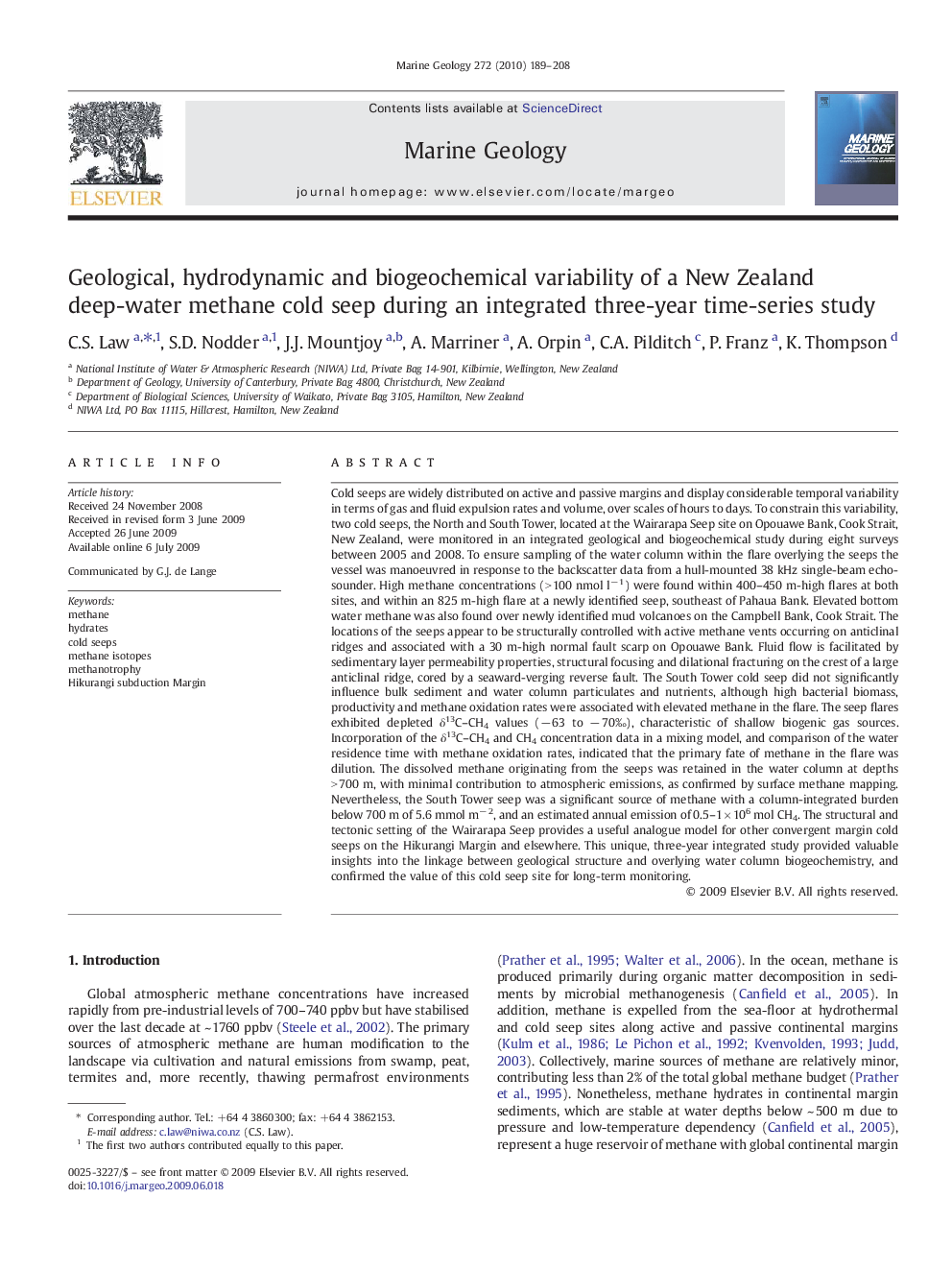| کد مقاله | کد نشریه | سال انتشار | مقاله انگلیسی | نسخه تمام متن |
|---|---|---|---|---|
| 4718809 | 1639149 | 2010 | 20 صفحه PDF | دانلود رایگان |
عنوان انگلیسی مقاله ISI
Geological, hydrodynamic and biogeochemical variability of a New Zealand deep-water methane cold seep during an integrated three-year time-series study
دانلود مقاله + سفارش ترجمه
دانلود مقاله ISI انگلیسی
رایگان برای ایرانیان
کلمات کلیدی
موضوعات مرتبط
مهندسی و علوم پایه
علوم زمین و سیارات
ژئوشیمی و پترولوژی
پیش نمایش صفحه اول مقاله

چکیده انگلیسی
Cold seeps are widely distributed on active and passive margins and display considerable temporal variability in terms of gas and fluid expulsion rates and volume, over scales of hours to days. To constrain this variability, two cold seeps, the North and South Tower, located at the Wairarapa Seep site on Opouawe Bank, Cook Strait, New Zealand, were monitored in an integrated geological and biogeochemical study during eight surveys between 2005 and 2008. To ensure sampling of the water column within the flare overlying the seeps the vessel was manoeuvred in response to the backscatter data from a hull-mounted 38 kHz single-beam echo-sounder. High methane concentrations (> 100 nmol lâ 1) were found within 400-450 m-high flares at both sites, and within an 825 m-high flare at a newly identified seep, southeast of Pahaua Bank. Elevated bottom water methane was also found over newly identified mud volcanoes on the Campbell Bank, Cook Strait. The locations of the seeps appear to be structurally controlled with active methane vents occurring on anticlinal ridges and associated with a 30 m-high normal fault scarp on Opouawe Bank. Fluid flow is facilitated by sedimentary layer permeability properties, structural focusing and dilational fracturing on the crest of a large anticlinal ridge, cored by a seaward-verging reverse fault. The South Tower cold seep did not significantly influence bulk sediment and water column particulates and nutrients, although high bacterial biomass, productivity and methane oxidation rates were associated with elevated methane in the flare. The seep flares exhibited depleted δ13C-CH4 values (â 63 to â 70â°), characteristic of shallow biogenic gas sources. Incorporation of the δ13C-CH4 and CH4 concentration data in a mixing model, and comparison of the water residence time with methane oxidation rates, indicated that the primary fate of methane in the flare was dilution. The dissolved methane originating from the seeps was retained in the water column at depths > 700 m, with minimal contribution to atmospheric emissions, as confirmed by surface methane mapping. Nevertheless, the South Tower seep was a significant source of methane with a column-integrated burden below 700 m of 5.6 mmol mâ 2, and an estimated annual emission of 0.5-1 Ã 106 mol CH4. The structural and tectonic setting of the Wairarapa Seep provides a useful analogue model for other convergent margin cold seeps on the Hikurangi Margin and elsewhere. This unique, three-year integrated study provided valuable insights into the linkage between geological structure and overlying water column biogeochemistry, and confirmed the value of this cold seep site for long-term monitoring.
ناشر
Database: Elsevier - ScienceDirect (ساینس دایرکت)
Journal: Marine Geology - Volume 272, Issues 1â4, 15 July 2010, Pages 189-208
Journal: Marine Geology - Volume 272, Issues 1â4, 15 July 2010, Pages 189-208
نویسندگان
C.S. Law, S.D. Nodder, J.J. Mountjoy, A. Marriner, A. Orpin, C.A. Pilditch, P. Franz, K. Thompson,